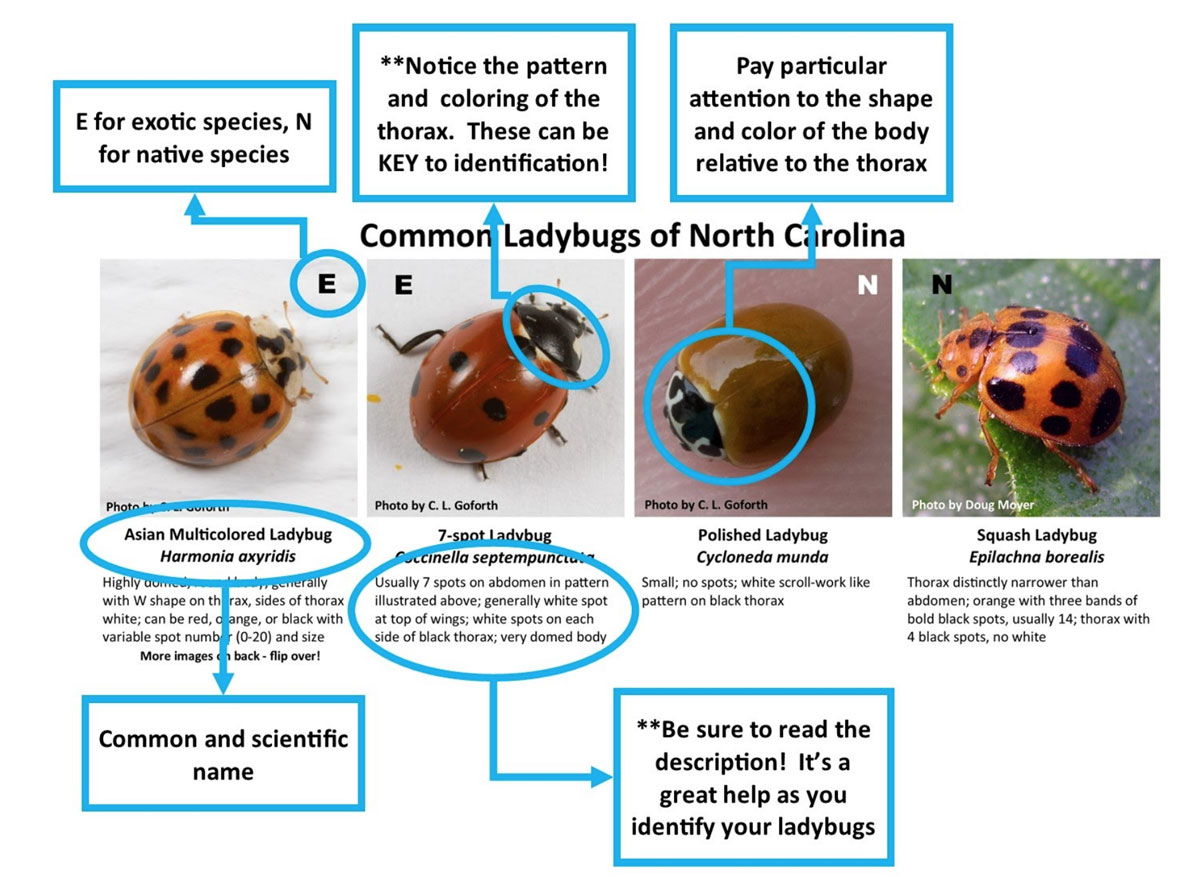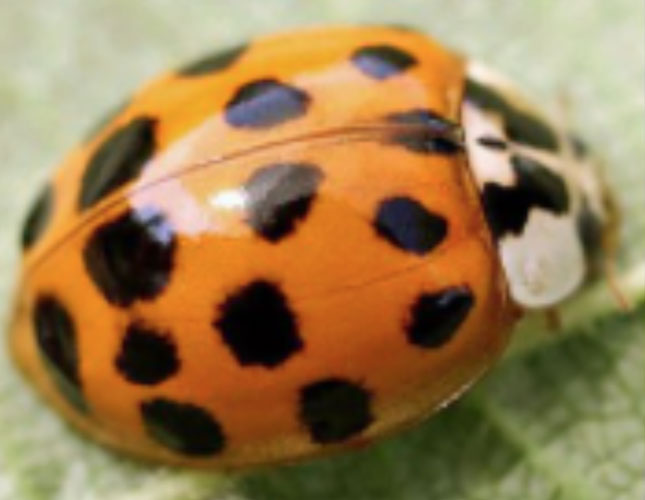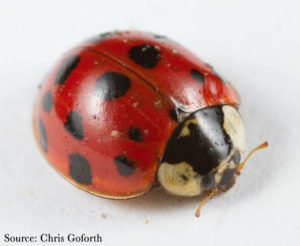Standards + Practices

Science Standards:
LS.5.2.3 Use models to infer the effects that may result from the interconnected relationship of plants and animals to their ecosystem.
Science Practices
SP1: Asking questions (for science)
SP2: Developing and using models
Resources + Supports

Comparing Findings
Are your students finding ladybugs at home? Consider spending some time discussing with students their home collections versus school searches, including what they might infer about your schoolyard and how it might be similar or different from their homes. This will help prepare students for data analysis in several months to follow.
Did you find the same types of ladybugs and in about the same numbers as last month? As students become familiar with identifying ladybug species and review their observations from the beginning of the year, students can revisit their initial predictions related to the two overarching scientific questions listed in August/September.

Mr. Jones Manages Data Collection

Ladybug Field Guide
To assist students in identifying the ladybugs they find, the following field guide has been created highlighting common ladybugs of North Carolina: Common Ladybugs of NC Field Guide. This document provides a picture, the common and scientific names, a brief description, as well as a label for exotic (non-native) and native species for each ladybug (If possible, it would be helpful to print color copies and laminate them for student use.). As students use this guide to identify the ladybugs they have found, have them pay particular attention to the color and design on the ladybug’s thorax and its overall color, rather than just counting the number of spots. It is much easier to identify a ladybug by the design on its thorax than the number of spots!


Identifying Ladybugs
Representations can be descriptive pictures, in this case of ladybugs, that spark interest, answer or create questions, and overall, provide a different view of a concept for understanding. In this activity, students will use a field guide and photographs of ladybugs as representations to identify the species they are and generate questions regarding the species and where they were found on their school grounds. Inspire students to generate questions related to the representation:
- What do I notice and wonder about this ladybug?
- Am I identifying the correct species?
- What more can I find out about the ladybug?
This month, throughout the activities, focus on how students are using the field guides and photographs to assist them in identifying the ladybugs this month. See the science and literacy content support box above for more details on what information is included in the field guide and how students might access these representations to formulate questions and provide evidence for investigations throughout this activity.

Ladybug Identification
The media guide contains a tutorial video on identifying common ladybugs in North Carolina titled “Ladybug Identification Tutorial.” which can be used for your reference or shared with students. Please refer to the All About Ladybugs PDF from the Lost Ladybug Website for more information regarding the ladybug life cycle.

Not Finding Ladybugs?
There may be times when no ladybugs are found during an outdoor exploration and may prove disappointing for students, but it is important to submit these data on the website nonetheless.
Why is it important to submit a zero?
A zero is still an important number to submit, as it still gives scientists data for research. For Lost Ladybug, scientists can compare where and how you collected, how many people collected for how long, the time, date, weather and habitat, and would benefit from knowing that no ladybugs were found during that time, or at that location, just as much as they would from knowing what ladybugs were found.
The following article discusses “The Positive Side of Zero.”
How do you submit a zero?
During the submission process, complete the form and record a “no” under the heading “Did you find and photograph ladybugs?”
Tips for handling student disappointment:
- Remind students of the importance of collecting zeros for data entry for the scientists’ analyzing the data and that ladybugs can be challenging to find.
- Harness this disappointment for the activities in April and May/June when students can choose to advocate for “no pesticide zones,” more garden spaces on campus, or other habitat enhancements to attract more ladybugs.
- Return to one of the hook activities from August/September to build student enthusiasm once again.
- Play a game by hiding pictures of ladybugs around your school grounds. (See December Outdoor Protocols support for more detail).
- The more frequently you search for ladybugs, the greater the chance you will have of spotting them. Give students ample opportunity to search for ladybugs, perhaps by adding extra time to “go a long way” to a specials class or the cafeteria, extending recess time to include time for searching, or taking students to a different location on your school grounds.
- Encourage students to look for ladybugs at home.
- Guide students in identifying the methods that are most successful for finding ladybugs and documenting those methods for use in the future.

Finding Other Insects
Students are likely to find other insects while searching for ladybugs, and their curiosity and wonder about them may distract them from the ladybug search. It will be worthwhile to take time to allow students to explore all of the various insects they discover, as this will aid in their identification and classification skills for data collection. Consider asking students the following questions about the other insects they discover:
- Is this an insect too? How do you know?
- How could we identify what this insect is?
- How is this insect similar to a ladybug? How is it different?
What if other insects and ladybugs are nowhere to be found?
In certain regions of the state, the weather may already be getting colder, which may make it difficult to find other insects, as well as ladybugs, while out searching. If students are having difficulty finding ladybugs, refer to the January Monthly Engagement which contains several science content and outdoor learning supports detailing information about overwintering and exploring outside in cooler months.
- Is this an insect too? How do you know?
- How could we identify what this insect is?
- How is this insect similar to a ladybug? How is it different?

Ladybug Identification Quiz



1b. Explain how the features you listed in part (a) could help you identify the ladybugs.
2. Draw a ladybug in the space provided below and label its major parts.
Teacher Note: Pay particular attention to how students respond to both parts of question 1. Identifying ladybugs is a large part of their work with LLP. If students struggle to identify features that can be used for identification and explain how they are used to make identifications, consider using one ladybug picture to model the process a person would go through to identify it using a field guide. While modeling, have students record the features used and compare them with the field guide pictures. If students identify the ladybugs instead of explaining how they used ladybug features to make an identification, encourage students to go back and explain their process. In addition, be sure students are focused on the ladybug anatomy in their response to question 2.

Name That Ladybug

Be sure that students report the location, conditions, and how they conducted their observations when they don’t find ladybugs since their “zeroes” are also useful.

In next month’s activities, students will be considering what a ladybug’s role is in an ecosystem, in particular searching for evidence of ladybugs as consumers. Pay particular attention to the outdoor learning support prior to taking students outside to aid in this search. In addition, students would benefit from a strong understanding of the importance of zeroes as data (see the Science Content support) as finding ladybugs may prove to be more difficult than students expect.

 Continue to support students in collecting and photographing the ladybugs they find as they follow procedures introduced in August/September. Introduce students to a
Continue to support students in collecting and photographing the ladybugs they find as they follow procedures introduced in August/September. Introduce students to a 